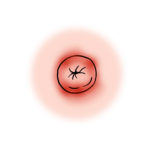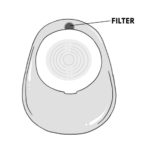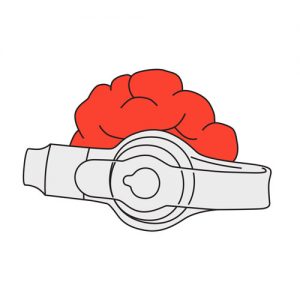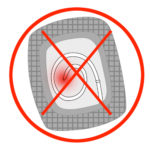Cough assist care
PLEASE NOTE: The information in this section is meant as a general guide to help parents and caregivers with common issues and is not intended to replace the care provided by your child’s healthcare team.
Discuss your child’s unique needs with the healthcare team, including WHO and WHEN to contact when problems arise.
Stomach upset during lung volume recruitment technique or insufflation/exsufflation technique
Chest/abdominal discomfort or pain during lung volume recruitment (breath stacking) or insufflation/exsufflation technique
Dizziness or fatigue
Bloating of the abdomen with burping after lung volume recruitment technique or insufflation/exsufflation technique
Inability to expectorate (clear) the secretions
Leak around the mouthpiece during lung volume recruitment technique or insufflation/exsufflation technique
Leak from the nose during lung volume recruitment technique or insufflation/exsufflation technique
Abdomen does not move outwardly during lung volume recruitment technique or insufflation/exsufflation technique
Tracheostomy care
WARNING: The information in this section is meant as a general guide for parents and caregivers with certain problems related to children with tracheostomy using a simple non-fenestrated, cuffless tracheal cannula. It is not intended to replace the recommendations of your child’s healthcare team.
Discuss your child’s unique needs with the healthcare team, including WHO and WHEN to contact when problems arise.
One or more of these symptoms: coughing more frequently, yellow, green, pink or blood tinged secretions, secretions are thicker, secretions are more abundant than usual, secretions have a bad odor, labored breathing, breathing more quickly, chest pain, fever (≥ 38⁰C rectal or ≥ 37.5⁰C oral or ≥ 37.5⁰C underarm), irritability, loss of energy, loss of appetite/refusal to eat
One or more of these respiratory distress symptoms: labored breathing, more comfortable in a sitting position or with head elevated than in a lying down position, rapid, noisy or wheezy breathing, shallow breathing, secretions are more abundant than usual, weak cough, indrawing (retraction of the skin over, under and in between the ribs), use of accessory muscles to help with breathing, nasal flaring (enlargement of the nostrils during breathing), extension of the neck backwards to try to breathe in air, continuously crying, agitation, anxiety, irritability, scared look on your child’s face, marked sweating, pale skin, blue color of lips and nail beds
Resistance or impossibility of tracheal cannula reinsertion
Tracheal cannula falls out, partially or completely, accidental decannulation: cuffless tracheal cannula partially or completely out
Blood-tinged secretions
Bleeding from inside the tracheostomy or around the tracheostomy
Introduction of water into the tracheostomy
One or more of these symptoms: coughs and /or choking during meals, saliva more abundant than usual, secretions are more abundant after meals, secretions resemble the liquids or food that was recently ingested, traces of food are found during suctioning of tracheal secretions, vomiting right after a meal
Vomiting
Skin around the tracheostomy site irritated (redness, edema, itchiness, burns, bad odor, oozing, presence of red pimples, small sores or bleeding and/or tracheostomy dressing is wet and soiled)
Skin around the neck irritated (redness, edema, itchiness, burns, bad odor, oozing, presence of red pimples, small sores or bleeding)
Aspiration of secretions
WARNING: The information in this section is meant as a general guide for parents and caregivers with certain problems related to aspiration of secretions. It is not intended to replace the recommendations of your child’s healthcare team.
Discuss your child’s unique needs with the healthcare team, including WHO and WHEN to contact when problems arise.
Resistance or impossibility to insert the aspiration catheter into the tracheal cannula
Resistance or impossibility to insert the aspiration catheter via the nose
Difficulty or impossibility to aspirate secretions
Blood-tinged secretions
Any one or more of these respiratory distress symptoms following aspiration of nasopharyngeal or tracheal secretions: labored breathing; more comfortable in a sitting position or with head elevated than in a lying down position; rapid, noisy or wheezy breathing; shallow breathing; weak cough; indrawing (retraction of the skin over, under and in between the ribs), use of accessory muscles to help with breathing; nasal flaring (enlargement of the nostrils during breathing); extension of the neck backwards to try to breathe in air; continuously crying; agitation; anxiety; scared look on your child’s face; pale skin; blue color of lips and nail beds
Vomiting during the aspiration of secretions
Nosebleeds after nasopharyngeal aspiration
Prolonged cough or spasms of cough during aspiration of nasopharygeal or tracheobronchial secretions
Pallor (paleness), blue lips or blue nails; oxygen desaturation, as indicated by a monitor
Weakness, fainting or loss of consciousness
Suction device noisy
Suction device not working
Ventilatory assistance
WARNING: The information in this section is meant as a general guide for parents and caregivers with certain problems related to invasive ventilation, non-invasive ventilation and manual ventilation. It is not intended to replace the recommendations of your child’s healthcare team.
Discuss your child’s unique needs with the healthcare team, including WHO and WHEN to contact when problems arise.
Problems related to invasive ventilation and non-invasive ventilation
Ventilatory assistance device alarms
Ventilatory assistance device does not turn on (no lights or alarms)
Disconnected parts in the ventilation circuit
Broken equipment: interface or any components of the ventilation circuit (eg, tubing, tracheostomy adapter)
Insufficient air flow from the ventilatory assistance device
Warmer air than usual in the ventilation circuit
Dropped ventilatory assistance device (device falls to the ground)
Irregular display on the ventilatory assistance device
No water in the water chamber of the ventilatory assistance device
Presence of condensation in the ventilation circuit
Presence of condensation in the mask and/or your child has droplets of water on the face during non-invasive ventilation
Accumulation of water in the tubing of the ventilation circuit
Leakage of water from the water chamber of the ventilatory assistance device
Child agitated, crying, uncomfortable and/or having difficulty falling asleep
Sensation that the ventilatory assistance device pushes the air more forcefully or is noisier than usual
Irritation (redness, sores) of facial skin and/or eyes redness, in the child who uses a mask
Dryness of the nose, in the child who uses a mask
Nose or sinus congestion, in the child who uses a mask
Red, dry or irritated eyes, in the child who uses a mask
Mouth dryness, in the child who uses a facial mask
Bloated belly or abdominal distension during invasive or non-invasive ventilation
Difficulty to speak or swallow during non-invasive ventilation
Problems related to manual ventilation
Absence of movement of the chest during manual ventilation
Unable to compress the ventilatory bag during manual ventilation
Vomiting during manual ventilation
No resistance during compression of the ventilatory bag during manual ventilation
Distention of the abdomen during manual ventilation
Peritoneal dialysis
WARNING: The information in this section is meant as a general guide for parents and caregivers of children with certain problems related to peritoneal dialysis. It is not intended to replace the recommendations of your child’s healthcare team.
Discuss your child’s unique needs with the healthcare team, including WHO and WHEN to contact when problems arise.
Problems related to the material
Discharge, redness, heat, swelling, bad odor and/or pain around the catheter insertion site
Bump or red line near the catheter insertion site with redness, swelling, pain or tenderness and/or discharge
Wet dressing
Disconnection between patient line and extension during dialysis
Disconnection between MiniCap disconnecting cap and extension tubing
Disconnection between the extension and the catheter
Contamination of the extension tip during dialysis connection
Drainage from the bag during the dialysis session
Cycler alarms
Dislodgement of the catheter; catheter cuff visible outside the insertion site
Problems related to the peritoneal dialysis session or the child's general condition
Cloudy effluent (as if milk had been added) with any of these symptoms: Constant pain in the belly; Chills; Fever (≥ 38⁰C rectal or ≥ 37.5⁰C oral or ≥ 37.5⁰C axilla); Nausea; Vomiting; Decreased effluent drainage; Headache; Loss of appetite; Fatigue; Abdominal muscle cramps or spasms (stiffness, pain)
Filaments (threads) or small white pieces in the effluent
Pink or red effluent
Slow or blocked infusion of the dialysate
One and/or the other of these symptoms: Rapid increase in weight compared to your child's dry weight; Swelling of the hands, ankles, feet, around the eyes and/or face; Hypertension (high blood pressure); Difficulty breathing; Shortness of breath; Low urine output
One and/or the other of these symptoms: Rapid weight loss compared to your child's dry weight; Dizziness; Less saliva, dry lips; Low blood pressure; Orthostatic low blood pressure (low blood pressure and increased pulse) when the child moves from a lying to a sitting position); Increased pulse rate; Muscle cramps, especially in the legs; Weakness; Dark eyes
Decrease in ultrafiltration/decreased effluent
Abdominal cramps during drainage
Constipation
One and/or the other of these symptoms: Fatigue; Muscle weakness; Decreased energy; Increased sleep
Shoulder pain
Itching
Diarrhea
Restless legs (need to move the legs at night or while lying down)
Enterostomy care
WARNING: The information in this section is meant as a general guide to help parents and caregivers with common issues and is not intended to replace the care provided by your child’s healthcare team.
Discuss your child’s unique needs with your healthcare team, including WHO and WHEN to contact when problems arise.
Watery stool
Constipation
Irritated skin around the stoma: red, swollen, burning, presence of small red bumps, small wounds or slight bleeding
Unpleasant odors
Skin protector does not stick properly to the skin
Detachment of the bag
Bleeding from the stoma
Movement of the stoma: sinks inward or sticks out by more than 0.5 centimeters from its usual position
Enteral nutrition
WARNING: The information in this section is meant as a general guide for parents and caregivers with certain problems related to enteral nutrition. It is not intended to replace the recommendations of your child’s healthcare team.
Discuss your child’s unique needs with the healthcare team, including WHO and WHEN to contact when problems arise.
NOTE: For ease of reading the rest of the text, the word (nutritional) “formula” also includes “breast milk”, “fortified breast milk” or “infant formula”.
Problems related to nasal tube
Difficulty or inability to irrigate the nasal tube
Difficulty or inability to aspirate stomach (gastric) contents from the nasal tube
Displacement of the nasal tube
Accidental removal of the nasal tube
Difficulty or inability to insert the nasogastric tube (eg, tube coils in the mouth or comes out through the mouth)
Redness around the nostril in a child with a nasal tube
Breathing difficulties (severe coughing, difficulty breathing, noisy breathing, choking, bluish lips, agitation) during nasogastric tube insertion
Discharge through the nasal tube
Bleeding; blood in the nasal tube
Problems related to button or enterostomy long tube
Drainage through or around the button or enterostomy long tube
Accidental removal of the button or enterostomy long tube
Red, crusty, moist, thick, red tissue around the stoma: looks like cauliflower or a turtleneck, soft to the touch, bleeds easily and may leak yellowish/brownish, sticky fluid
Redness of the skin around the stoma with or without tenderness, warmth, swelling, discharge different from the usual yellowish or brownish secretions, bad smell and/or fever (≥ 38⁰C rectal or ≥ 37.5⁰C oral or ≥ 37.5⁰C armpit)
Difficulty or inability to aspirate stomach (gastric) contents from the gastrostomy button or long tube
Difficulty or inability to irrigate the button or the enterostomy long tube
Difficulty or inability to insert gastrostomy balloon button or long tube
Button or enterostomy long tube breakage (in place)
Disconnection of the extension set during the feeding session
Bleeding through or around the stoma
Blood in the (stomach) gastric aspirate from the button or enterostomy long tube
Outward movement of the button or enterostomy long tube
Inward movement of the button or enterostomy long tube
Unable to deflate the balloon of the gastrostomy button or tube (in place)
Inability to rotate the gastrostomy balloon button
Problems related to feeding session or general condition of the child
Feeding pump alarms
Difficulty or inability to administer formula or medication through the tube or button (eg, inability to push the plunger on the feeding syringe, blocked or slowed flow of formula by gravity or pump)
Nausea and/or vomiting between feeding sessions
Nausea and/or vomiting during feeding session
Breathing difficulties (eg, coughing, choking, noisy and/or wheezy breathing, increased work of breathing (retraction of the skin around the ribs and collarbones), bluish discoloration of the lips and skin) during a feeding session
Bloating / swelling of the belly during feeding session
Bloating / swelling of the belly between feeding sessions
Abdominal pain during feeding session
Diarrhea (soft or liquid stools more frequent than usual) with or without cramps and/or abdominal pain
Constipation (infrequent and/or difficult to pass stool for more than a day) with or without nausea, vomiting, abdominal bloating, cramps and/or abdominal pain
Dry mouth
Yellowish or greenish vomiting (bile) or yellowish or greenish liquid visible in the feeding tube
One or more of these symptoms between feeding sessions: Headaches; Chest pain; Vomiting; Blurred vision; Perspiration (sweating); Pallor (pale skin); Fatigue or irritability; Tremors (shakiness); Convulsions
One or more of these symptoms during and/or after feeding session: Headaches; Chest pain; Strong thirst; Weakness; Agitation; Irritability; Abdominal cramps; Diarrhea; Urine more often than usual
One or more of these symptoms: Increased thirst; Dry and sticky tongue; Dry and chapped lips; Hollow or sunken eyes; Darker urine, strong odor and in smaller quantities than usual; Urine less often than usual; Weakness; Dizziness
One or more of these symptoms: Faster breathing, difficulty breathing; Swelling especially in the legs, feet and around the eyes; Quick and sudden weight gain
Parenteral nutrition
WARNING: The information in this section is meant as a general guide to help parents and caregivers with common issues and is not intended to replace the care provided by your child’s healthcare team.
Discuss your child’s unique needs with the healthcare team, including WHO and WHEN to contact when problems arise.
Redness, heat, swelling or tenderness or pain at the catheter entry site
Extended redness or itching of the skin under dressing
Cord-like sensation of the vein where the catheter is inserted (may be hard, red or tender to touch)
One or more of these symptoms: burning or pain at the entrance site of the catheter, cold skin around the entrance site of the catheter, swelling of the arm (PICC line), swelling around the catheter site, leakage at catheter entry site, change in skin color (whiteness or redness) around the catheter entry site
For those with an implantable chamber catheter (eg, Port-a-Cath®): pain or swelling at the site of insertion of the reservoir during the administration of the solution or irrigation
Blood leaking at catheter insertion site
Protective dressing is wet or damp due to leakage of blood, pus or other discharge
Dressing is falling off, loose, punctured or torn
Presence of blood in catheter tubing
More residual solution than usual in the bag at the end of administration
More air bubbles than usual or presence of particles in the bag, whether the additives have already been added or not
Re-separation of the solution (before or during administration) after mixing the contents of the two chambers
Ambulatory infusion pump alarms
Resistance or inability to irrigate (flush) the catheter
Inadvertent disconnection of connector without needle or pump tubing
Broken (leaking) catheter or malfunctioning equipment
External displacement of the catheter (part of the catheter outside the vein shorter or longer than usual or catheter completely removed from the vein) with or without: pain in the ear, neck or shoulder on the side of the catheter, swelling in the neck, unusual sound heard by your child on the catheter side during flushing of the catheter or administration of the medication
Unusual sound heard by your child on the catheter side during irrigation with or without: pain in the ear, throat pain
Particular odor or a strange taste reported by your child during catheter irrigation
One or more of these symptoms: nausea, vomiting, headache, blurred vision, cold sweats, pallor, tiredness or irritability, seizures
One or more of these symptoms: headache, nausea, increased thirst, weakness, agitation, irritability, increased urination
One or both of these symptoms: dry skin, dry mouth, significant thirst, weakness, dizziness, decreased urination
One or more of these symptoms: faster breathing, difficulty breathing, swelling especially in the legs/feet or around the eyes, decreased urination, unexpected rapid weight gain
Fever with or without general malaise: ≥ 38⁰C rectal or ≥ 37.5⁰C buccal or ≥ 37.5⁰C armpit
One or more of these symptoms: swelling of the arm or side where the catheter is located, underarm pain in the arm where the catheter is located, swelling of the neck and face
Intravenous antibiotic therapy
WARNING: The information in this section is meant as a general guide to help parents and caregivers with common issues and is not intended to replace the care provided by your child’s healthcare team.
Discuss your child’s unique needs with your healthcare team, including WHO and WHEN to contact when problems arise.
Redness, heat, swelling, tenderness or pain at the catheter entry site
Extended redness or itching of the skin under dressing
Cord-like sensation of the vein where the catheter is inserted (may be hard, red or tender to touch)
One or more of these symptoms: burning or pain at the entrance site of the catheter, cold skin around the entrance site of the catheter, swelling of the arm (PICC line), swelling around the catheter catheter site, leakage at catheter entry site, change in skin color (whiteness or redness) around the catheter entry site
Child with an implantable chamber catheter (eg, Port-a-Cath®): pain or swelling at the site of insertion of the reservoir during the administration of the solution or irrigation
Blood leaking at catheter insertion site
Protective dressing is wet or damp due to leakage of blood, pus or other discharge
Dressing is falling off, loose, punctured or torn
Presence of blood in catheter tubing
Medication administration time longer than usual
Leakage of the elastomeric infusion pump or bursting of the balloon
Presence of air bubbles or particles in the bag, cassette reservoir or elastomeric infusion pump
Ambulatory infusion pump alarms
Resistance or inability to irrigate (flush) the catheter
Inadvertent disconnection of the needleless connector or the pump tubing
Broken (leaking) catheter or malfunctioning equipment
External displacement of the catheter (part of the catheter outside the vein shorter or longer than usual or catheter completely removed from the vein) with or without: pain in the ear, neck or shoulder on the side of the catheter, swelling in the neck, unusual sound heard by your child on the catheter side during flushing of the catheter or administration of the medication
Unusual sound heard by your child on the catheter side during irrigation with or without: pain in the ear, throat pain
Particular odor or a strange taste reported by your child during irrigation
One or more of these symptoms: swelling of the hand, arm or side where the catheter is located, underarm pain in the arm where the catheter is located, swelling of the neck and face
Fever with or without other symptoms: ≥ 38⁰C rectal or ≥ 37.5⁰C buccal or ≥ 37.5⁰C armpit
Intermittent bladder catheterization
WARNING: The information in this section is meant as a general guide to help parents and caregivers with common issues and is not intended to replace the care provided by your child’s healthcare team.
Discuss your child’s unique needs with your healthcare team, including WHO and WHEN to contact when problems arise.













